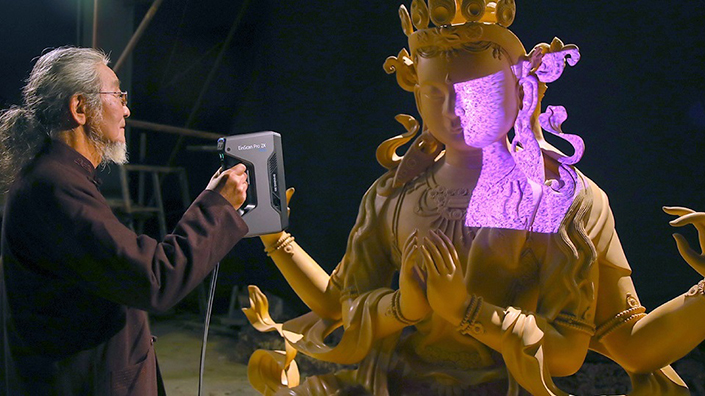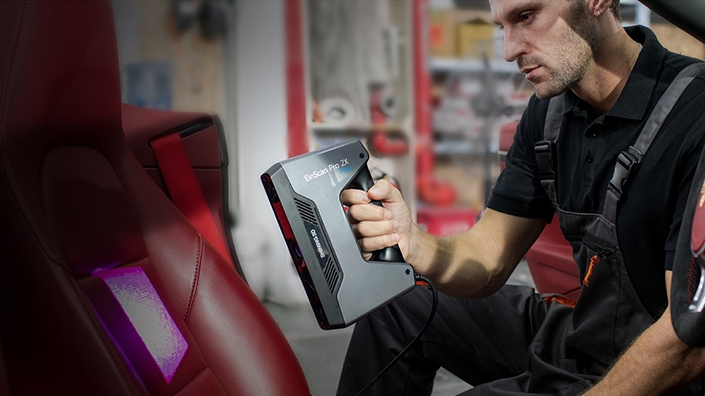At first glance it looks like some kind of primitive ritual, perhaps to bring luck at the racecourse. Or perhaps he is just mad.
But in fact the tool is a 3D scanner and the man is capturing an image of the horse’s body. After just 30 seconds the job is done and the tablet connected to the scanner shows a detailed and accurate 3D reconstruction of the animal.
As this scene illustrates, 3D scanners have come a long way in the past decade. “Eight years ago it was very much a niche technology,” says James Earl, managing director of 3D-scanning company OR3D, and the man scanning the horse. “You’d have arm-type systems – very expensive bits of kit that were £30,000 to £40,000 upwards. Now you can pick up a 3D scanner for £1,500 that has phenomenal accuracy that you connect straight into your laptop.”
This accessibility, combined with powerful new software, means not just medium-sized companies such as OR3D, but small firms and even solo engineers can get hold of a handheld device and start scanning, inspecting and reverse engineering pretty much anything they want. These lightweight devices are typically structured-light scanners that project patterned light onto the object being scanned.
The interference in the light pattern caused by the object’s surface is captured by one or more cameras on the scanner and the data is triangulated in the software to calculate the object’s depth and surface patterns. These relatively cheap and easy-to-use pieces of technology can now capture a full large object – such as a horse – in under a minute and to sub-micron accuracy.

3D scanners can easily scan large objects (Credit: EinScan)
The process of reverse engineering too has become more streamlined, with software that integrates 3D scans into CAD. It begins with the scan data itself – a point cloud with X, Y and Z co-ordinates. “The software instantly translates that point cloud to create a polygon file,” explains Grant Cameron, managing director of 3D technology company CDG, “and that polygon file gives you a 3D visualisation so you can see what you’re scanning.” When scanning is finished, software is used to fill in any holes that were missed by the scan itself, creating a closed mesh.
Designs on the data
From here the product can be sent for 3D printing or CNC machining, or used for quality assurance inspection. Alternatively it could be modified or reverse engineered using CAD, once the polygon data has been converted via special software such as Geomagic’s Design X. The length of time the process takes depends on the complexity of the geometry. “A very complex project can take up to a week,” says Cameron. “A simple project can take half an hour.”
The range of projects a company like CDG or OR3D might take on is surprisingly large. The most typical jobs fall into two main areas – inspection for quality assurance purposes and reverse engineering for design and prototyping.
A typical job for OR3D might be reverse engineering parts for racing teams. “They’ll be working with a car manufacturer who can’t give them the CAD for the car,” says Earl. “It’s just too sensitive. But invariably they need to know. So they might say, ‘I’ve got the roll cage here and I need to know the safety points’. So we’ve gone in and scanned the vehicle or part of it so they can build around it.”
Other projects might be legacy items such as classic car parts that are no longer manufactured. A big part of legacy work comes from defence and aerospace contracts where the machines involved might have been built several decades ago using 2D CAD or before CAD was developed. “They still need to fix bits,” says Earl, “so they want a digital library of everything.”
Going back in time
The size doesn’t top out at tanks or planes. OR3D is scanning the M25 using scanners that are fitted onto the backs of trucks. London’s orbital motorway was built in the 1970s and 1980s, and parts of it haven’t been changed for several decades, according to Earl. The problem is that the original design drawings no longer show the fine details of how it actually looks today. “We’ve saved hundreds of thousands of pounds on the M25,” says Earl, “by doing virtual reconstruction so they can have a look at the actual plan and go, ‘Oh, we didn’t see that’.”
From the very big to the very small – OR3D also scans parts for the healthcare industry. One application is in facial reconstruction surgery. Earl’s team uses CT scan data to help reconstruct missing pieces of bone and also provide a guide which the surgeons use during operations. “Using that technology has reduced what would be a 20-hour operation down to six,” says Earl.
The applications aren’t limited to engineering and healthcare, either. OR3D gets a lot of work from museums, often to create replicas of pieces that are too fragile to exhibit. Earl gives the example of a medieval skeleton of a person who died of a bone-wasting illness. Every time the remains were exhibited they decayed a little more. So Earl and his team scanned and 3D-printed models that could be shown to the public. 3D scanning has even been used to analyse dinosaur footprints, enabling experts to work out the size, weight and even gait of the creature that produced them from exact depth measurements.
Weird and wonderful
The range of the work involved extends to the weird and wonderful, from scanning faces to make personalised face-shaped chocolates to copying body parts of porn actors for sex toys. Clearly no two days are the same. Earl says: “One day I’m in a military establishment, the next day I’m at a hospital, then at a museum, and everywhere in between. The breadth of uses of the technology is massive.”
Earl is insistent that he sees very little of the darker side of reverse engineering – counterfeiting and theft of intellectual property. But others are concerned about the increasing accessibility of the technology and how it could affect manufacturing, particularly when legislation fails to keep up.
“The majority of designers rely on unregistered rights,” says Dids Macdonald, chief executive of Anti Copying in Design (ACID), a campaigning organisation for design and intellectual property. “We see a lacuna in the law which would not provide a legal remedy for the majority of UK designers if copies are made through 3D printing.” This effectively means that things like prototypes could be counterfeited with impunity using 3D-scanning and printing technologies.

(Credit: EinScan)
The ease with which designs can be copied might force manufacturers to up their game. Researchers are already experimenting with ways of designing defects into products that would only appear when produced under suspicious conditions. One research team at the Institut Charles Sadron in Strasbourg, France is even looking at a method of encoding authenticating barcodes into polymers which can then become part of the very fabric of the product.
But Macdonald worries that, without adequate legal protection, the problem will become worse before it gets better, particularly in a post-Brexit UK where engineering and design will be a huge mainstay of the economy. “The design sector – and engineering is a great part of that – is worth £85bn to the UK’s gross value added,” says Macdonald. “It provides jobs for 1.5m people. So design is incredibly important but I still don’t think intellectual property enforcement is high enough on the government’s priorities.”
In any case, legitimate companies such as OR3D and CDG will continue to do what they do. Earl at OR3D is waiting on a CT scanner – like those used in hospitals – which will enable the company to scan not only the surface of objects but their insides too. This will be crucial for checking parts made using additive manufacturing so that the internal structure as well as the surface can be inspected for integrity.
“This is going to become more and more important as 3D-printed parts are being used as functional parts, not just for prototypes, where people don’t care so much,” says Earl. “So it’s actually going in a vehicle or an aircraft.”
Access for all
Earl sees the future of reverse engineering as one of greater automation. OR3D is working on ways of incorporating artificial intelligence (AI) into its processes to enable customers who don’t have the expertise to carry out the work themselves. This could be valuable in a wide field of applications, from doctors scanning body parts to workers on construction sites.
With the help of AI, Earl sees 3D scanners breaking into the consumer market, perhaps ultimately becoming as ubiquitous as cameras on smartphones. “It will be in every engineer’s toolbox,” he says. “Instead of going around taking pictures of this thing that has bust, you’ll just do a quick scan because it provides all that extra information.”
Content published by Professional Engineering does not necessarily represent the views of the Institution of Mechanical Engineers.